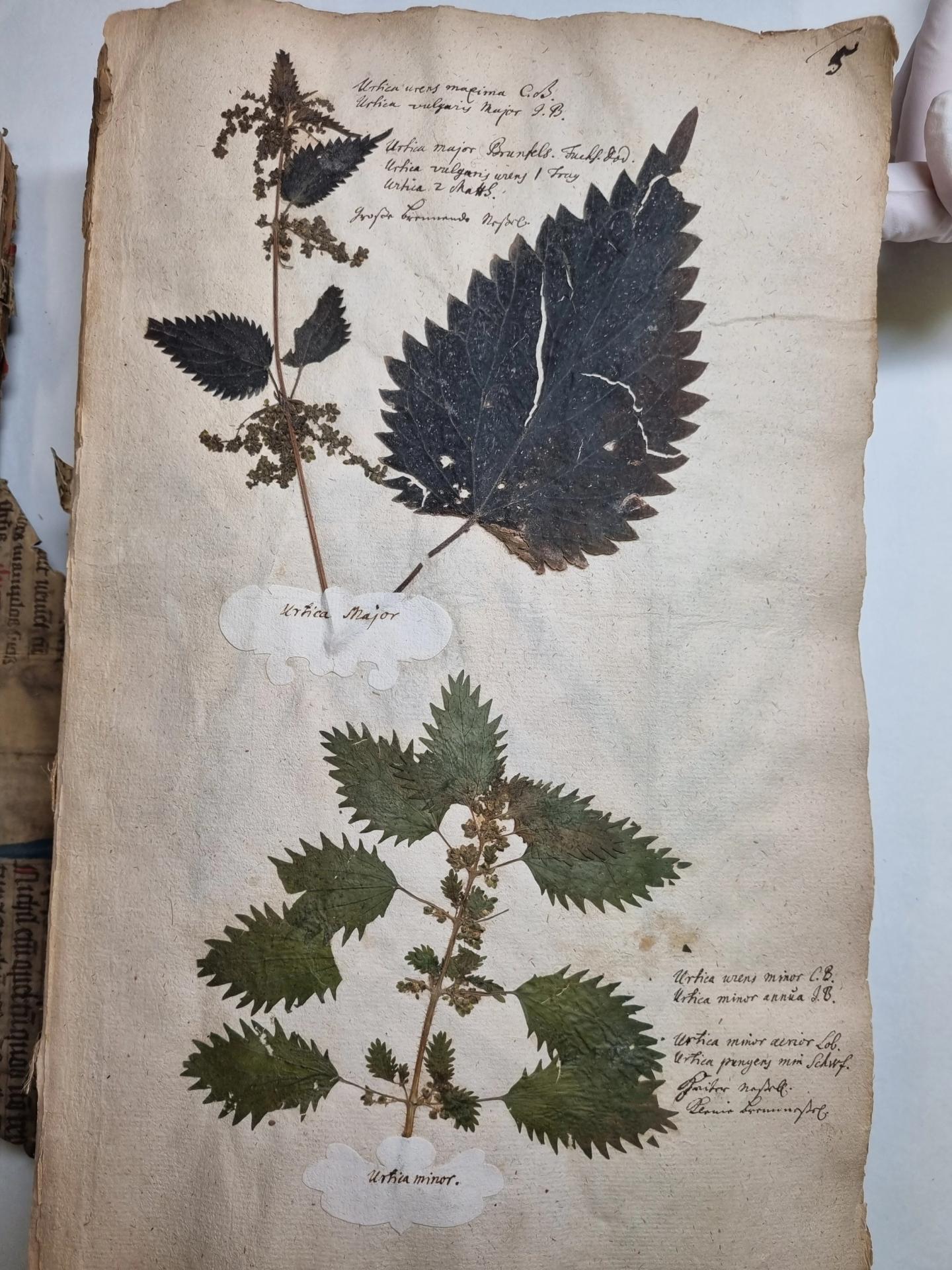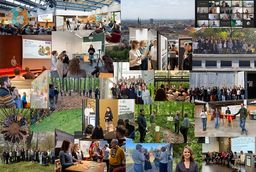
1,300 plants, more than 300 years old, dried between the pages of a book – that is the Herbarium Ruperti, a collection of pressed and glued plants from the late 17th century. An interdisciplinary research project of the Herzog August Bibliothek Wolfenbüttel in cooperation with the Institute of Plant Biology at TU Braunschweig and the Lower Saxony Center for Climate Research (ZKfN) now aims to explore this historical plant archive and to digitize the specimens from various locations in Lower Saxony, to botanically identify them and to analyze them from a scientific and cultural-historical perspective. The research results could provide insights into climate change in the past and provide insights into the historical biodiversity in Lower Saxony.
In October 2024, the three-year interdisciplinary research project “A testimony to ecclesiastical natural history and an archive of historical biodiversity - The Herbarium Ruperti (1700) of the HAB” was launched at the Herzog August Bibliothek Wolfenbüttel (HAB). In this cooperative project between the HAB, the Institute of Plant Biology at TU Braunschweigand the Lower Saxony Center for Climate Research, the 300-year-old Herbarium Ruperti, with its extensive collection of plants from what is now Lower Saxony, is to be restored, digitized, botanically catalogued and analyzed from a scientific and cultural-historical perspective. The project is being financed by the Lower Saxony Ministry for Science and Culture through the (special) funding lines “Cultural Heritage” and “Restoration and Conservation Work in State and University Libraries” as well as by the Braunschweig Cultural Heritage Foundation. The project will run for three years.
Dr. Thomas Biskup, head of the project at the Herzog August Bibliothek, is well aware that the research project requires the expertise of many different scientific disciplines: “Historical sciences, biology, restoration workshops and digital humanities are working together on several levels in this project to conserve and digitize the herbarium for the future and to research it from multiple perspectives.”
Testimony to pre-industrial biodiversity
“The plants preserved in the herbarium provide insights into the flora of Lower Saxony around 1700 and thus allow us to study changes in regional biodiversity and changes in vegetation and climate over more than 300 years, before industrialization and climate change reduced biodiversity through habitat loss, the extinction of species and air and soil pollution,” Biskup continues.
Herbaria have been established since the late 16th century, initially in the vicinity of Italian universities. However, since the first inventories of regional flora in Germany did not come about until around 1800, the Herbarium Ruperti represents a uniquely early collection of plants from Lower Saxony. The herbarium was created by the Protestant clergyman Georg Andreas Ruperti around 1700 and contains about 1,300 dried plants from present-day Lower Saxony. In 2019, the Herzog August Bibliothek Wolfenbüttel was able to acquire the book from a private British collection with special funds from the state of Lower Saxony.
Fragile and contaminated with biocides
Before the scientific analysis of the plants it contains can begin, the herbarium must first be restored. Treatments of the book in the 19th and 20th centuries have made it highly fragile. In addition, it is contaminated with biocides. The restoration is carried out by a team from the Conservation and Restoration Department of the Herzog August Bibliothek. Subsequently, the herbarium will be digitized by a specialized external service provider. The digitized material will be made freely accessible to researchers in the Wolfenbüttel Digital Library (WDB).
After digitization, the plants in the Herbarium Ruperti will be botanically identified at the Institute of Plant Biology at Technische Universität Braunschweig and the locations of the plant parts will be localized, thus enabling a historical inventory of the regional flora. “This will be a particular challenge due to the treatment of the herbarium with various highly toxic substances,” explains Prof. Robert Hänsch from the Institute of Plant Biology. “In some cases, it is also necessary to identify the herbarized plants using magnification (magnifying glass, microscope) on the specimen, since they cannot be identified beyond doubt by the naked eye,” adds Prof. Dietmar Brandes.
The Lower Saxony Center for Climate Research (ZKfN) is another partner in the interdisciplinary project. Together with the press office of the Herzog August Bibliothek, the ZKfN is supporting the public relations work and the further expansion of the network.
Insights into the history of culture, the environment and science
A historical review of the development of the native flora is particularly valuable for several reasons and provides an important basis for work in archaeobotany [editor's note: the interface between archaeology and botany]. The work of seed banks and methodologies for evaluating historical plant finds, for example, will benefit from the expected project results. Last but not least, the herbarium offers insights into the stress physiology of native tree species, thus enabling an understanding of how historical plant species reacted to climate changes in the past.
At the same time as the plant-based research, the herbarium is being examined from a cultural, environmental and scientific-historical perspective. The author Ruperti worked at the British court in London for decades and, through spiritual networks, was active in the global sphere of influence of the pietistic movement, for which the exchange and study of natural history objects from all parts of the world was a matter of course. The botanical collecting and ordering logics are thus placed in their social, cultural and historical-scientific context and the structure of nature and religion, social order and knowledge order is discussed.
Project website:
https://www.hab.de/zeugnis-geistlicher-naturkunde-und-archiv-historischer-biodiversitaet/
Contact persons
- Prof. Dietmar Brandes und Prof. Robert HänschInstitute of Plant Biology and Botanical Garden, Technische Universität Braunschweig
 Katharina Zickwolf, M.A. / M.A.Managing Director
Katharina Zickwolf, M.A. / M.A.Managing Director
More Posts
All
Happy Holidays!
We wish everyone relaxing days, time to take a deep breath and a good start to the new year. We will be available again from 5 January.
1 min. Reading time
2025 Year in Review – The ZKfN Year in Pictures
2025 was marked by the expansion of the Climate Future Labs, new collaborations and a more closely networked climate community in Lower Saxony.
5 min. Reading time
How collaboration across disciplinary boundaries works
The workshop at the ZKfN symposium showed the prerequisites for interdisciplinary and transdisciplinary collaboration and the added value it creates.
3 min. Reading time
